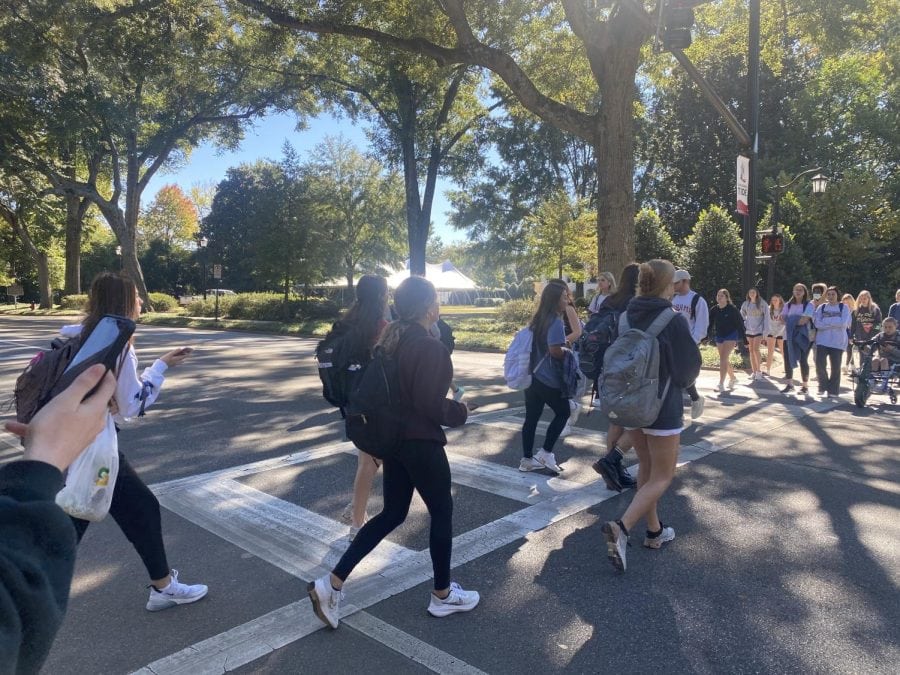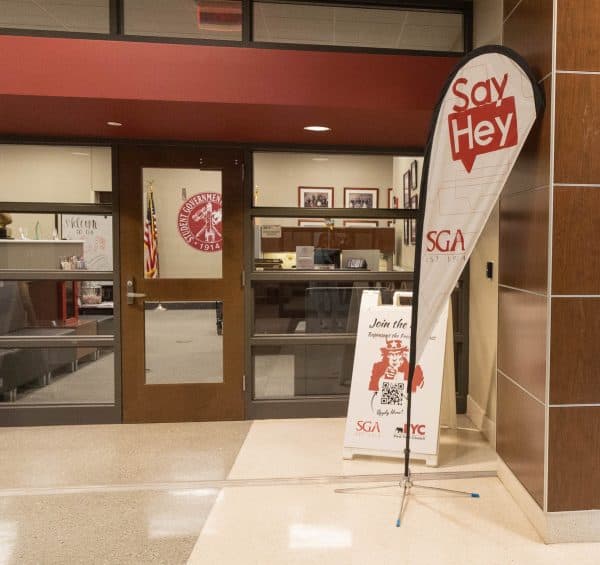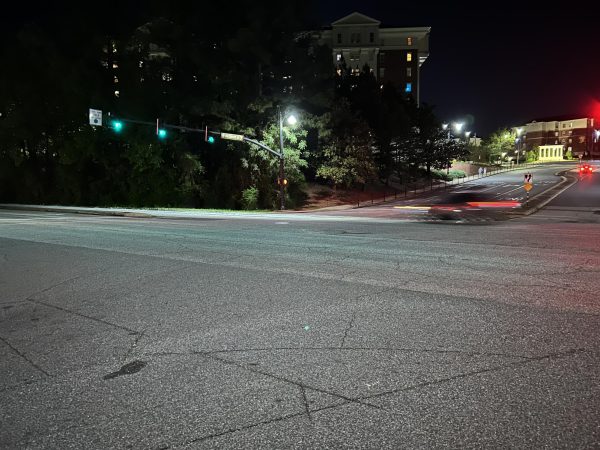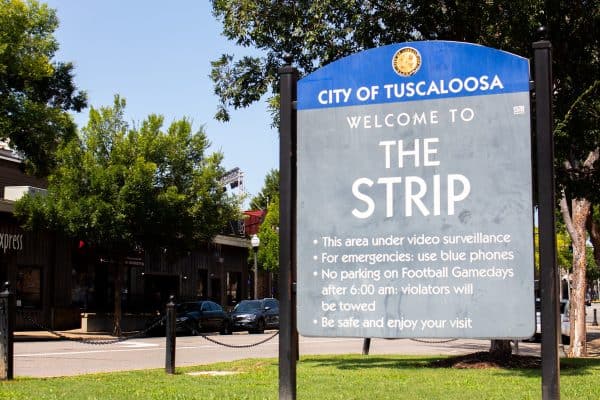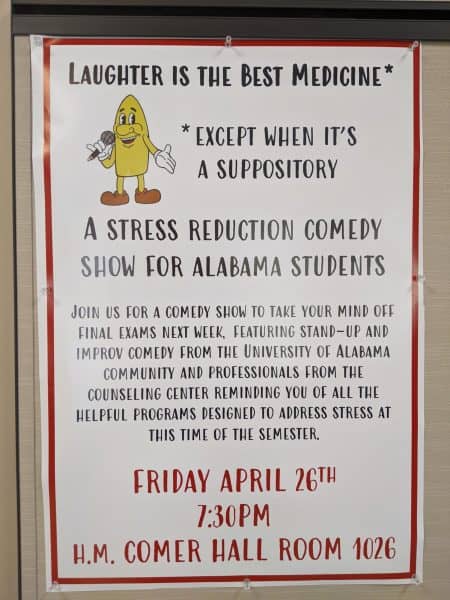Are campus crosswalks safe?
Students cross University Boulevard on November 10, 2021.
November 18, 2021
For UA student Caroline Horn, warnings about the crosswalks started during an early move-in camp for new students.
“The only thing I remember from Camp 1831 was our team leader telling us the crosswalks get slippery when it rains,” UA student Caroline Horn said.
With the painted lines of a crosswalk appearing to be a potent slipping hazard, some might wonder if there is something wrong with the paint.
“More than once I have been crossing and slipped,” engineering major Logan Burke said. “It happened so often that I bought new shoes thinking maybe mine just didn’t have enough tread, but it didn’t help. So now I walk beside the crosswalk instead of in it.”
The federal government regulates what materials can be used when marking a crosswalk. These guidelines are laid out in the Manual on Uniform Traffic Control Devices.
“Interestingly, only some portions of this 862-page manual are required. There are numerous optional statements and guidance,” said Armen Amirkhanian, a professor of engineering and an expert in cementitious materials.
The manual rarely mentions slipperiness. It only makes one statement about crosswalk material slipperiness for pedestrians: “Consideration should be given to selecting pavement marking materials that will minimize tripping or loss of traction for road users, including pedestrians, bicyclists, and motorcyclists.”
“Since this is a legal document, the word ‘should’ is really important,” Amirkhanian said. “As an engineer, I am not required to select a marking that will minimize tripping or loss of traction. I am recommended to do so.”
There is only one other mention of road marker slipperiness in the manual, which says “consideration should be given to selecting pavement marking materials that will minimize loss of traction for bicycles under wet conditions.”
“I’ve seen multiple bikers and skateboarders fall due to the rain on sidewalks,” freshman aerospace engineering major Sydney Moskalick said. “I’m not sure if it’s a coincidence, but I only see it when it rains.”
Freshman criminal justice major Madison Towner would suggest it’s not a coincidence.
“I refuse to walk directly on the crosswalk when it rains because I have [fallen and almost fallen] too many times,” Towner said.
Part of why slipperiness is not more of a priority when choosing crosswalk marking materials is that there is no national standard for measuring it and therefore no way to regulate it.
Researchers like Somayeh Nassiri at Washington State University are using the British Pendulum Number scale for slipperiness evaluation in studies on pavement. A project report authored by Nassiri looked into evaluating the safety of pavement marking for bicyclists. The report tested three different pavement marking material types evaluated in dry, wet and icy conditions.
Based on the findings from the analysis, centerline striping may be a beneficial technique to prevent bicycles from slipping. Other countries have their own units of measuring slippage on walking surfaces and the impact related to road markers. Those units are helping American researchers create safer road conditions and could be utilized as part of a future federal road marking material regulation.
Every state’s department of transportation approves certain materials for marking pavement, but not every project is subject to these rules. Amirkhanian said that because contractors are generally familiar with the rules, though, the rules are often followed even where they do not apply.
UA Director of Transportation Services Chris D’Esposito said the approximately 500 crosswalks on campus are repainted every summer and worn ones are subject to a midyear refresher coat. He said many factors contribute to the crosswalks’ slipperiness.
“The inclement weather element, a lot of rain, condensation, wintery mix of snow and ice. Then, what is the shoe style? A smooth-sole shoe or something with more traction?”
D’Esposito said his department uses Hotline Fast Dry Latex Waterborne Traffic Marking Paint to mark crosswalks on campus.
“We take anything to do with safety very seriously,” he said. “We use the best recommended products.”
D’Esposito said Hotline Fast Dry Latex paint contains reflective glass beads for safe driving at night and sand to retain coarseness.
“The primary objective for any pavement marking is to indicate hazards and deviations from expected flow to the traveling public,” Amirkhanian said. “That is, we are first concerned with drivers. Pedestrians are expected to be observant of their surroundings and yield to dangerous situations, like vehicles traveling on the road. Because of this focus, there is not a significant concern of the friction performance of pavement markings, as they would minimally impact the traveling public.”
Amirkhanian said that some materials exist that can be added to paint to increase friction but that those additives can create much more danger.
“The main issue with these types of materials is durability,” he said. “Any material with high friction would wear down much quicker, especially in a crosswalk application. A crosswalk boundary that is worn and poorly visible is much more dangerous for the driver and pedestrian than a slippery but highly visible and well-defined crosswalk boundary.”
On Tuscaloosa’s rainy days, some UA students might continue slipping and sliding their way to class. Students on campus on one of those rainy days shouldn’t let the slick crosswalks slip their mind.
This story was published in the Rumor Edition. View the complete issue here.
Questions? Email the News desk at [email protected].

